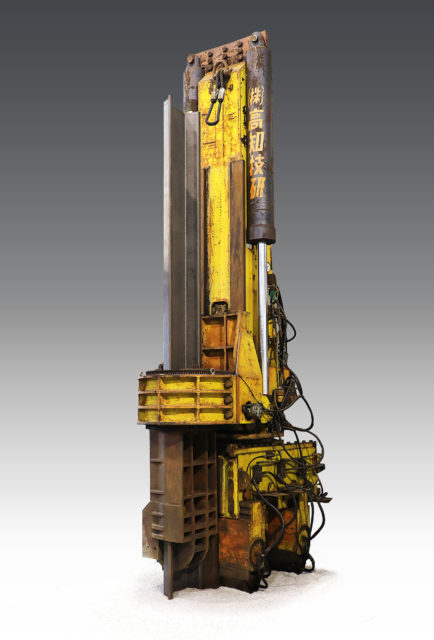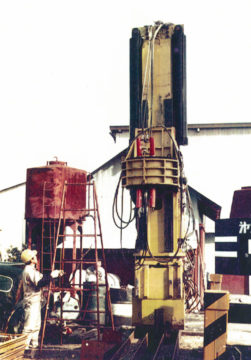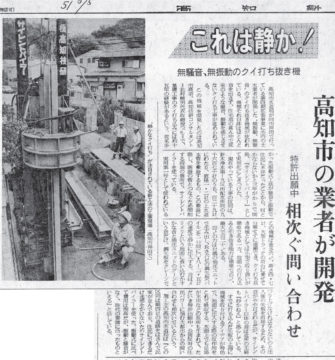On July 30th, The Japan Society of Mechanical Engineers (JSME) announced that KGK-100A, the world's first reaction-based hydraulic pile jacking machine, would be certified as Mechanical Engineering Heritage. JSME designates historically significant achievements in machine technology as Mechanical Engineering Heritage. The date of accreditation is August 7th, 2021.
The certification system aims to clarify Japan's world-class machine heritage and disseminate it to the world. KGK-100A would be listed as the 113th machine and is the first product to be certificated from the Kochi Prefecture. GIKEN is extremely honored that a Kochi-born machine is recognized as one of Japan's leading technologies.
KGK-100A was invented in 1975 and is the first machine to realize the Press-in Principle, founded by Akio Kitamura, founder and Executive Chairman of GIKEN. The Press-in Principle eliminates noise and vibrations of piling construction, which was said to be a source of construction pollution. The machinery has continued to evolve and develop since then, and GIKEN continues to provide solutions to global construction issues with innovative methodology and technology.
We will continue to promote the revolution of construction methods with the SILENT PILER as our core business and technology originating from Japan.
The Press-in Principle utilizes the previously installed pile's extraction resistance (reaction force), which stables the machine and installs the next pile using a static load. Compared to hammering or impact driving, the press-in method does not generate vibration or noise. Hence, the effects on the surrounding environment are lower compared to conventional pile driving methods. When installing a pile, a reaction force is exerted to lift the machine upward. For example, installing with a press-in force of 100 tons would generally require a machine with more than 100 tons of weight, increasing the size of the required plant. On the other hand, the SILENT PILER is lightweight and compact because it utilizes reaction force without relying on its own machine weight. Installation works can be carried out in urban areas and residential areas.

KGK-100A
Preserved at GIKEN Kochi Head Office
■ About the Mechanical Engineering Heritage
In 2007 The Japan Society of Mechanical Engineers commenced accreditation of machinery of historically significant achievements in machine technology to preserve and pass them on to the next generation for posterity. This accreditation has four categories, and KGK-100A was certified as "Collection: stored and collected machinery." Other certified machineries include Japan’s first dynamic weaving machine, the Non-Stop Shuttle Change Toyoda Automatic Loom-Type G, the KOMATSU Bulldozer G40 (Komatsu Type 1 Soil Leveling Machine), the first bulldozer manufactured in Japan, Japan's first domestic passenger aircraft in the post-war period, the Passenger Aircraft YS11 and the Hydraulic Excavator UH03, a hydraulic excavator produced for the first time in Japan. The conditions for certification are consistent with either "those that demonstrate important achievements in the history of the development of machinery technology" or "those that contribute to people's lives, cultures, economics, society, and technological education" in machine technology.
■ About the SILENT PILER KGK-100A
Background of inventing the machine
During the post-war era, Japan grew economically with construction booming and its’ pollution becoming a significant societal problem. Conventional Piling methods [hammering and vibrations] were said to be the prime cause and were significantly impacting the surrounding environment and residents' lives. During this time, Mr. Kitamura established the predecessor of GIKEN Group, the Kochi Giken Consultant, under the slogan "a company who will deal with construction pollution." He craved for a piling machine that did not generate noise or vibration, however when he could not find this both within and outside Japan, he decided to invent it himself.
Discovery of the Press-in Principle
The discovery of the Press-in Principle was due to an event Mr. Kitamura saw at a construction site before founding the company. The H steel installed in the earth was in the process of being extracted. Suddenly, the H Steel tore apart. Mr. Kitamura was greatly surprised by the resilience of the ground. He hypothesized that if you seize several piles already installed in the ground, you will "capture the earth" and utilize that force.
Invention of Unit 1, on-site debut of Unit 2
In 1973, Mr. Kitamura and the late Mr. Yasuo Kakiuchi [the latter called the Thomas Edison of Kochi], began to embrace the Press-in Principle. Overcoming numerous difficulties, the two developed the first SILENT PILER in July 1975. KGK-100A was named from the acronym of Kitamura, GIKEN, and Kakiuchi, 100 ton press-in force, and A for the first machine. The following year, the second unit, with improvements, debut at a construction site, surprising the media and neighboring residents who visited. Kochi newspaper articles at that time had headlines that conveyed innovation: "It's silent!"

Photo of the first field test of Unit 1

Article from Kochi Newspaper 1976 titled “Its’s Silent!”
Noise comparison between impact hammer piling driver
According to an experiment at that time, the sound levels of the impact hammer pile driver were 100 decibels(dB), and KGK-100A was 55 dBs (Measuring distance 10m). 100 dB is the same noise level of hearing a train passing under a railway viaduct, and could cause severe hearing impairment. Comparatively, the sound level of 55dB is considered the noise level of regular conversations.
Machine Specification
| Mass | 13,000kg | Maximum Press-in Force | 1,000kN |
| Overall Height | 5,250mm | Maximum Extraction Force | 1,000kN |
| Overall Width | 1,050mm | Applicable pile material | U-shaped steel sheet pile 400mm wide |
| Overall Length | 2,500mm |
■GIKEN recognition
Providing a variety of values of the Press-in
The value brought by the SILENT PILER is not limited to vibration-free, noise-free and workspace efficiency. The values are eliminating the need for temporary platforms, ensuring equipment stability and maintaining safety, with high construction accuracy. We provide outstanding, one-of-a-kind construction solutions with a diverse range of benefits and innovations of the Press-in Principle. Reducing construction time and costs also contributes significantly to decarbonization. Automated driving technology is also making remarkable progress globally and we are proud to be at the forefront of automating pile drivers.
Making Kochi the Mecca of the Press-in Principle
To date, we have produced more than 3,600 SILENT PILER machines, and adoption of the Press-in Piling technology has grown to more than 40 countries and regions worldwide. At Kochi Head Office's World Piling Museum, we exhibit the first-generation SILENT PILER and various other types of piling machines. We are in the process of developing a facility to showcase more of the history and benefits of the Press-in Principle. Taking this certification as a momentum, we will continue to publicize where SILENT PILER was born and make Kochi a "mecca" of the Press-in Principle.
■Profile of GIKEN Group
GIKEN developed the SILENT PILER, the world's first reaction-based hydraulic pile jacking machine, installing piles with no noise and vibration. GIKEN Group now actively promotes the Press-in Technology worldwide and contributes to the construction industry by proposing and implementing innovative solutions. The innovative technology of press-in provides a unique solution and the adoption of this technology has grown to more than 40 nations and regions.
GIKEN LTD.
International Business Department
TEL: +81-3-3528-1633 (weekdays: 8:30 to 17:30)
Tokyo Head Office: 16F Ariake Central Tower, 3-7-18 Ariake, Koto-ku, 135-0063, Japan


